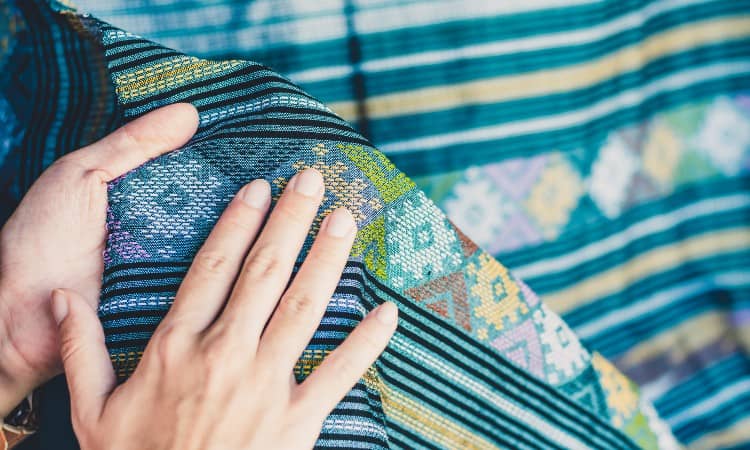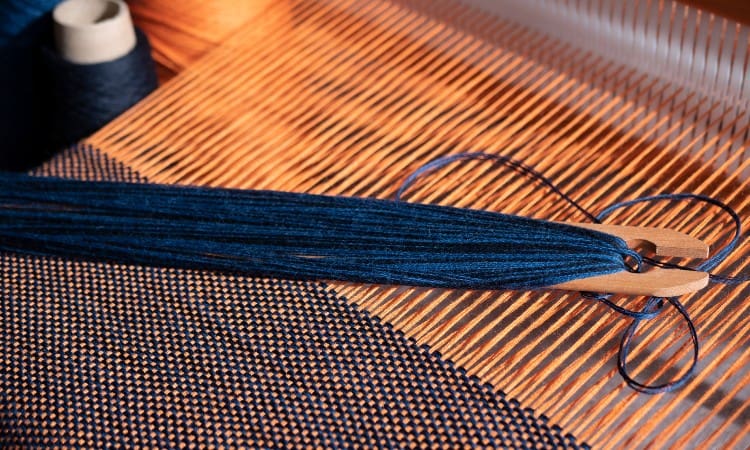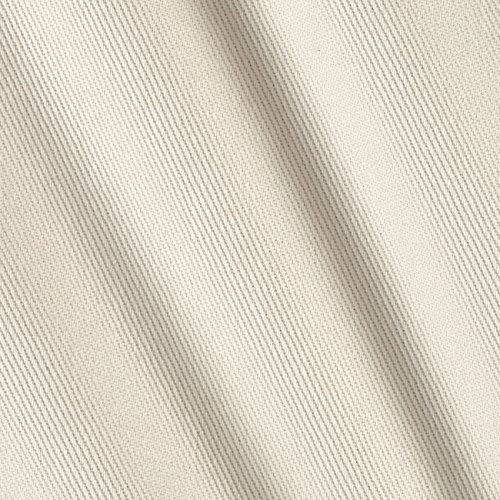If you’re new to sewing, you’ve probably heard the term woven fabric. You may be wondering what kind of fabric that is and what it is used for. Woven fabric isn’t a specific type of fabric but rather a group of different fabrics that share similar characteristics. That’s why I’ve created this guide to answer “what is woven fabric exactly?”
There are two main categories of fabric: woven and knit. Woven fabric is a fabric that is made by weaving the individual fibers together rather than knitting them. It can be made from different types of fibers. Examples of woven fabric include denim, flannel, and velvet, among others.
In this article, you’ll learn what woven fabric is, its characteristics, how it is made. I’ll also discuss different examples of woven fabric and what the fabric as a whole is used for. That way, you can be more knowledgeable when choosing fabric for your sewing project.

What is Woven Fabric?
 When creating a fabric, two main factors go into it. The first is what type of fiber the fabric will be made from. For example, the fabric can be made of cotton, polyester, silk, linen, rayon, etc. But the second factor is how one or more of those fibers are put together: either knit or woven.
When creating a fabric, two main factors go into it. The first is what type of fiber the fabric will be made from. For example, the fabric can be made of cotton, polyester, silk, linen, rayon, etc. But the second factor is how one or more of those fibers are put together: either knit or woven.
With that being said, woven fabric refers more to the way fabric was created, not what the fabric is made of. You can have knit fabrics made from cotton, but you can also have woven fabrics made from cotton.
Woven fabrics are fabrics that were created on a loom. The fabric is made by weaving two or more threads together at right angles, either of the same or different fibers. This process creates a fabric with a specific texture and characteristics, but the exact appearance, as well as certain characteristics, just depend on what type of fiber the fabric was made from.
How Are Woven Fabrics Made?

The weaving process has been around for thousands of years, in which things such as baskets, clothing, and blankets were created by hand with or without the help of a loom. Fortunately, due to modern technology, most woven fabrics no longer have to be created by hand. But the overall process for creating them is the same.
Today, woven fabrics are created on a mechanical loom. The process starts by placing two groups of threads perpendicular to each other. The vertical threads are known as the warp threads, while the horizontal threads are known as the weft threads. The weft threads are woven between the warp threads to create the finished fabric.
The use of a mechanical loom allows the weaving process to be done more efficiently. It also allows larger pieces of fabric to be created at one time. However, some woven fabrics are made with more delicate fibers, for example, certain types of silk fabrics. As you can imagine, being hand-woven makes fabrics more rare and expensive and even highly sought after in some cases.
What Are the Characteristics of Woven Fabrics?

The exact texture, appearance, and the way you care for woven fabrics will be different if the fabric is made from cotton versus polyester. But, no matter what type of fiber woven fabric is made of, the overall characteristics are still the same. Let’s look at each of these characteristics in more detail.
Structure
Of the two categories of fabric- knit and woven- woven fabrics are stronger. They’re frequently used to make sturdier items or items that are designed to be worn more. Woven fabrics tend to retain their shape well. Most of them aren’t considered drapey fabrics, although some of them have more drape than others.
Stretch
Woven fabrics are not as stretchy as knit fabrics. Most woven fabrics only stretch diagonally unless they are made with elastic fibers to increase stretchiness. Woven fabrics with a lower thread count or a looser weave will have more stretch than fabrics that are more tightly woven.
Durability
Woven fabrics are very durable and tend to last for a long time. We’ve already mentioned that it retains its shape and is less likely to stretch out of shape. But, woven fabrics can also withstand many washes. It doesn’t pill as much and is less likely to pull and snag due to how the threads are woven together.
Texture
Remember that the exact texture of woven fabrics depends on what type of fiber the fabric is made of. But in general, woven fabrics tend to have a coarser texture instead of being soft. They may also be heavier and stiffer. Woven fabrics also tend to wrinkle and crease more easily since they hold a certain shape better, so they may have to be ironed more frequently.
Cost
Even with being made on a mechanical loom, the process of weaving fabric is still more intensive due to the precise and sometimes complex weaving methods. Because of this, woven fabrics tend to be a little more expensive than knit fabrics, although the exact cost will depend on the fiber it is made with.
Sewing
Woven fabrics are very easy to sew with since they don’t stretch as much. They are less likely to move or gather under the needle. However, woven fabrics do tend to fray at the edges, so it is important that you hem them properly to prevent this from happening.
Woven Fabric Types
There are three types of woven fabric depending on how the fibers are woven together. Certain weave types are used to create specific fabrics, which can cause the texture and appearance of woven fabrics to vary. Here are the three different types of weaves.
Plain Weave
 Plain weave is the most basic and the most common type of weave. Most woven fabrics will be made using a plain weave.
Plain weave is the most basic and the most common type of weave. Most woven fabrics will be made using a plain weave.
In plain weave fabrics, the weft yarn is woven over and under each warp yarn to create the highest number of intersections and the tightest weave. However, this type of weave does tend to wrinkle more easily.
Twill
 A twill weave is a weaving pattern in which the weft thread passes over two or more weft threads before crossing over. That pattern is then repeated one warp thread over.
A twill weave is a weaving pattern in which the weft thread passes over two or more weft threads before crossing over. That pattern is then repeated one warp thread over.
This creates a weave that is diagonal in appearance. Fabrics made with a twill weave are often heavier and more durable and less prone to wrinkling.
Satin
 Woven fabrics made with a satin weave tend to have a more glossy and lustrous appearance. The weave is created by passing four or more weft yarns over a single warp yarn, then four or more warp yarns over a single weft yarn.
Woven fabrics made with a satin weave tend to have a more glossy and lustrous appearance. The weave is created by passing four or more weft yarns over a single warp yarn, then four or more warp yarns over a single weft yarn.
It is the loosest of the three weave types and can get caught and snag more easily, causing pulls in the fabric.
Examples of Woven Fabrics
Here are some examples of different woven fabrics as well as the type of weave they are usually made with:
- Chiffon – a plain weave fabric that is sheer, airy, and lightweight. It is mainly created from rayon, silk, or polyester and is used for summertime blouses and accessories, such as scarves.
- Chintz – a plain weave fabric that is usually made from cotton. It is a medium-weight fabric that usually has a floral print and is glazed. Chintz is mainly used for dresses and pajamas.
- Corduroy – a thicker, twill weave fabric that has ribbing on the surface. It is usually made of cotton or polyester fibers for pants, skirts, and shirts.
- Denim – a twill weave fabric in which the warp threads are dyed blue while the weft threads are left white. This gives denim its unique color and appearance. It is typically made from cotton and used to make jeans.
- Flannel – a loosely woven fabric that can be either twill or plain-woven. It is brushed on one side to give it a soft texture. It is typically made from wool or cotton and used to make shirts and pajamas.
- Gabardine – a tightly woven twill weave fabric that has a raised texture. It is a strong fabric typically made from cotton and used to make suits, overcoats, and raincoats.
- Georgette – a plain weave fabric that is lightweight and sheer. It is made with twisted yarns that create puckers on the surface, giving it a crinkled appearance. Georgette is made from silk, rayon, or polyester and is used to make evening dresses.
- Organza – a plain weave fabric that is lightweight and sheer. Originally made from silk, it is now mostly made out of polyester or nylon. It usually has a stiff finish and is typically used for women’s clothing.
- Poplin – a plain weave fabric made with coarse weft yarns and fine warp yarns. It can be light or medium weight and is usually made from cotton, polyester, silk, and sometimes lycra. Poplin is used to make shirts and dresses.
- Velvet is a luxurious fabric made on a special loom and can be made with a plain, twill, or satin weave. An extra set of warp threads are sheared to give it a unique and soft texture. It is usually made from silk, cotton, or polyester. Velvet is used to make clothing and for upholstery.
What Is Woven Fabric Used For?
Due to its durability, woven fabrics are typically used for clothing that gets a lot of use, or even occasional use clothing that you want to stay in good shape. The exact use of woven fabrics depends on the specific fabric. But in general, these fabrics are used for clothing that doesn’t necessarily need a lot of stretch but that you want to last for a long time.
For example, denim is one of the most widely used woven fabrics. It is used for blue jeans, which get a lot of wear. Not all woven fabrics are heavy, but some are to make them able to be used for outerwear or cold-weather clothing.
Sheer woven fabrics such as georgette and chiffon are delicate fabrics usually only worn on special occasions. But being woven allows them to be durable enough to last a long time with proper care. Another common use for woven fabrics is for upholstery and household items that get a lot of use, such as curtains and bedding.
Is Cotton a Woven Fabric?
Cotton is a type of fiber that can be knit or woven. It is not a woven fabric in itself. Remember that “woven” refers to how a fabric is made, not what it is made of. Cotton is simply a type of fiber used to make woven fabrics, including broadcloth, corduroy, denim, gabardine, and poplin.
How Can You Tell If Fabric is Woven?
If you’re unsure what a particular fabric is and whether or not a fabric is woven, there are ways that you can tell. The first way is to look at the threads. You’ll have to look at the individual threads to be able to tell, but woven fabrics will have threads that criss-cross over each other instead of having loops like knit fabrics do.
The second way to tell is to stretch the fabric. Remember that woven fabrics only tend to stretch diagonally and not lengthwise or widthwise. Stretch the fabric in all directions and if there is any resistance, the fabric is most likely woven.
Finally, you can look at the fabric to see if it has wrinkles, or you can test for wrinkles. Just scrunch a piece of the fabric up and let go. Woven fabrics are more likely to show wrinkles after being let go or have creases in the fabric.
Woven Cotton Fabric by the Yard
Woven cotton fabric can range anywhere from $3.00 to more than $15.00 per yard. The exact price depends on the quality of the material and the brand and the type of cotton fabric that it is. Whether or not the fabric is solid or printed also plays a role in how much the fabric costs.
Fabrics that have a heavier weight will also cost more than lightweight woven fabrics. Twill weave cotton fabrics tend to cost more than plain weave ones, but again, the price also depends on the exact material type and the color or print of the fabric. Woven cotton fabric usually comes in widths ranging from 45 to over 60 inches, depending on the intended use for the fabric.
Conclusion
The most important thing to remember is that the term woven refers to how a fabric is made, not what the fabric is made of. There is a wide range of fabrics that are considered to be woven, and woven fabrics can be made from cotton, polyester, rayon, and even silk. If you’ve never used woven fabric, consider what you’re trying to make and the characteristics of the fabric before making your decision.